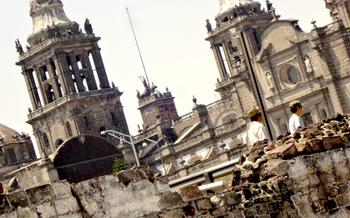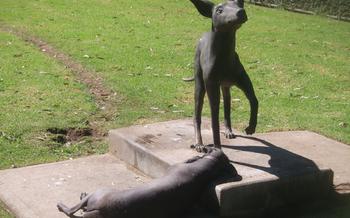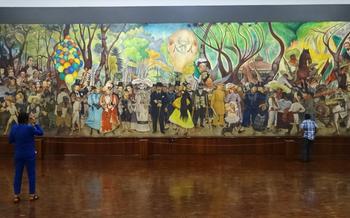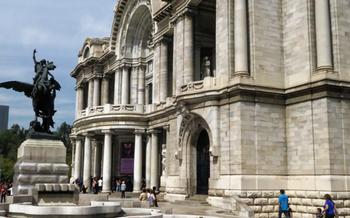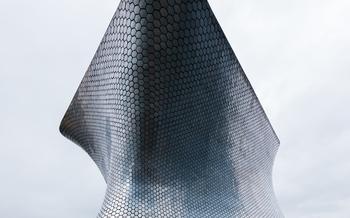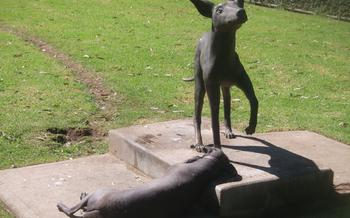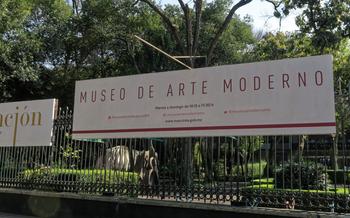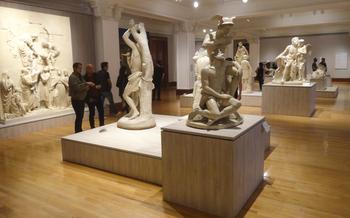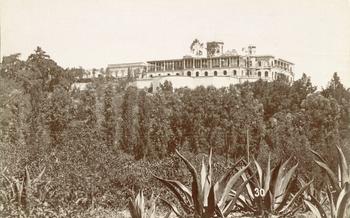
Museo de El Estanquillo
- The Museo de El Estanquillo: A Unique Collection
- Carlos Monsiváis: The Collector
- The Museum Building
- The Permanent Collection
- Temporary Exhibitions
- Educational Programs
- Events and Activities
- Visitor Information
- Getting to the Museum
- Tips for Visiting
- Nearby Attractions
- Historical Context
- Artistic Significance
- Cultural Importance
- Insider Tip: Uncovering Hidden Gems and Unique Experiences
The Museo de El Estanquillo: A Unique Collection
The Museo de El Estanquillo is a unique museum in Mexico City that houses a vast collection of Mexican art, ephemera, and popular culture artifacts. The museum was founded by the renowned Mexican writer and cultural critic Carlos Monsiváis, who spent his life amassing a collection of over 20,000 objects that reflect the rich and diverse history of Mexico. The Museo de El Estanquillo is a must-visit for anyone interested in learning more about Mexican culture and history.
The highlights of the collection include a wide range of items such as political cartoons, advertisements, toys, comic books, and religious objects. The museum also houses a significant collection of Mexican folk art, including masks, pottery, and textiles. The Museo de El Estanquillo is a treasure trove of Mexican culture and history, and it is a must-see for anyone visiting Mexico City.
The history of the museum begins with Carlos Monsiváis, who began collecting objects related to Mexican popular culture in the 1960s. Monsiváis was fascinated by the way that popular culture reflected the social and political changes that were taking place in Mexico. He believed that these objects were important historical documents that could help people to understand the country's past. In 2006, Monsiváis donated his collection to the Mexican government, and the Museo de El Estanquillo was founded.
Carlos Monsiváis: The Collector
Carlos Monsiváis was a renowned Mexican writer, essayist, and cultural critic who was passionate about collecting art and cultural objects. He believed that collecting was a way to preserve and celebrate Mexican heritage, and he spent decades amassing a vast and eclectic collection of over 20,000 pieces.
Monsiváis's collection included a wide range of items, from pre-Columbian artifacts and colonial paintings to folk art and popular culture objects. He was particularly interested in objects that reflected the everyday lives of Mexicans, and he sought to create a collection that would tell the story of Mexico's rich and diverse culture.
Monsiváis acquired the pieces in his collection through a variety of means, including purchases, donations, and trades. He was always on the lookout for new and interesting items, and he would often spend hours browsing flea markets, antique shops, and galleries. He also had a network of friends and collectors who would help him find rare and unique pieces.
Monsiváis's legacy as a collector is immense. His collection is now housed in the Museo de El Estanquillo, which he founded in 200The museum is a testament to Monsiváis's passion for collecting and his deep love for Mexican culture.
The Museum Building
The Museo de El Estanquillo is housed in a beautiful 17th-century palace known as the **Palacio palace was declared a national monument in 1931 and has been restored to its former glory.
The museum occupies the entire palace, with its 14 exhibition rooms spread over two floors. The ground floor houses the permanent collection, while the upper floor is dedicated to temporary exhibitions. The museum also has a library, a gift shop, and a cafe.
The Museo de El Estanquillo is located in the historic center of Mexico City, just a few blocks from the Zócalo. It is easily accessible by public transportation and there are several parking lots nearby. The museum is open Tuesday through Sunday from 10am to 6pm.
The Permanent Collection
The Museo de El Estanquillo's permanent collection is divided into several sections, each focusing on a different aspect of Mexican art and culture. The Arte Popular section features a wide range of traditional Mexican folk art, including colorful pottery, intricate textiles, and whimsical toys. The Caricatura section showcases the work of some of Mexico's most celebrated cartoonists, caricaturists, and political satirists. The Fotografía section features photographs from the late 19th and early 20th centuries that document Mexico's history and culture. The Gráfica section includes prints, engravings, and lithographs by some of Mexico's most renowned artists.
Some of the most notable works in the permanent collection include José Guadalupe Posada's iconic calavera etchings, Diego Rivera's caricatures of Mexican politicians, and Lola Álvarez Bravo's photographs of Mexican women. The collection is displayed in a variety of ways, including traditional vitrines, interactive displays, and multimedia presentations. The themes explored in the collection include Mexican identity, history, politics, and culture.
Temporary Exhibitions
Yes, the Museo de El Estanquillo actively hosts temporary exhibitions alongside its permanent collection, providing visitors with a dynamic and ever-changing museum experience. These exhibitions often explore specific themes or focus on the work of particular artists, offering a unique perspective on Mexican art and culture. The museum's curators carefully select these exhibitions to complement the permanent collection and provide visitors with a well-rounded understanding of Mexican art.
Temporary exhibitions at the Museo de El Estanquillo typically change every two to three months, ensuring a constant flow of fresh content for visitors to enjoy. The museum's website and social media platforms provide up-to-date information on upcoming exhibitions, allowing visitors to plan their visits accordingly. These exhibitions offer a valuable opportunity to delve deeper into specific aspects of Mexican art and culture, providing visitors with a comprehensive understanding of the country's rich artistic heritage.
Educational Programs
The Museo de El Estanquillo offers a variety of educational programs designed to engage visitors of all ages and backgrounds. These programs include guided tours, workshops, lectures, and film screenings.
Guided tours are available in Spanish and English, and provide visitors with an in-depth look at the museum's collection. Tours are led by knowledgeable docents who can answer questions and provide context for the works of art.
Workshops are offered on a variety of topics related to Mexican art and culture. Past workshops have included topics such as Mexican folk art, printmaking, and photography. Workshops are typically led by local artists and educators, and provide participants with the opportunity to learn new skills and create their own works of art.
Lectures and film screenings are held regularly at the museum. Lectures are given by experts on Mexican art and culture, and cover a wide range of topics. Film screenings typically feature Mexican films, both classic and contemporary.
The Museo de El Estanquillo's educational programs are a great way to learn more about Mexican art and culture. These programs are open to the public, and most are free of charge. For more information, please visit the museum's website or contact the education department.
Events and Activities
The Museo de El Estanquillo frequently enlivens its galleries with a diverse array of events and activities that delve into the captivating world of Mexican art and culture. These events are carefully curated to offer visitors a multidimensional experience, extending beyond the confines of traditional museum exhibits.
From intimate artist talks and thought-provoking lectures to captivating film screenings and engaging workshops, the museum provides a platform for renowned experts, emerging artists, and passionate enthusiasts to share their insights and creativity with the public. These events foster a sense of community, allowing visitors to connect with like-minded individuals who share a deep appreciation for Mexican art and culture.
To ensure that every visitor has the opportunity to participate, the museum hosts these events on a regular basis, ensuring a vibrant and dynamic calendar throughout the year. Whether you are a seasoned art aficionado or simply seeking a unique and enriching cultural experience, the Museo de El Estanquillo's events and activities offer something for everyone.
To stay abreast of the latest happenings at the museum, visitors are encouraged to check the museum's website or social media pages for up-to-date information on upcoming events and activities. By participating in these engaging programs, visitors can delve deeper into the stories behind the artworks, gain insights into the creative process, and forge meaningful connections with the vibrant artistic community of Mexico City.
Visitor Information
- The Museo de El Estanquillo is open Tuesday through Sunday from 11 am to 5 pm.
- Admission tickets cost 30 pesos for adults, 15 pesos for students and seniors, and free admission for children under
- The museum offers a 50% discount on admission on Sundays.
- Amenities available for visitors include a gift shop, a library, and a café.
- Guided tours of the museum are available in Spanish and English for an additional fee.
Getting to the Museum
Location: The Museo de El Estanquillo is located in the historic center of Mexico City, at Isabel la Católica 26, Col. Centro, Del. Cuauhtémoc, 06000 Ciudad de México, CDMX.
Public Transportation: The museum is easily accessible by public transportation. The nearest metro station is Allende, which is served by Line 2 (blue line). From the metro station, it is a short walk to the museum.
Driving: If you are driving to the museum, there are several parking options available. There are a few public parking lots located nearby, as well as street parking. However, please be aware that parking in the historic center of Mexico City can be challenging, especially during peak hours.
Accessibility: The Museo de El Estanquillo is wheelchair accessible. There is a ramp at the entrance of the museum, and the galleries are all on one level.
Tips for Visiting
-
The best time to visit the Museo de El Estanquillo is during the week, as it tends to be less crowded than on weekends. If possible, try to avoid visiting on Mondays, as the museum is closed.
-
Plan to spend at least two hours at the museum to fully appreciate the collection. There is a lot to see, so it is easy to get lost in the exhibits.
-
Guided tours are available in Spanish and English, and are a great way to learn more about the collection and its history. Tours typically last for about an hour and can be arranged in advance or on the day of your visit.
-
Be sure to wear comfortable shoes, as you will be doing a lot of walking. The museum is also not air-conditioned, so dress accordingly.
-
Photography is allowed in the museum, but flash photography is not permitted.
Nearby Attractions
The Museo de El Estanquillo is located in the historic center of Mexico City, which is home to a wealth of other cultural attractions. Visitors can easily combine a visit to the museum with other activities, such as exploring the nearby Plaza Mayor, visiting the Palacio Nacional, or taking a stroll through the Alameda Central park.
For those with limited time, here are some suggested itineraries:
- Morning: Visit the Museo de El Estanquillo, followed by a walk through the Alameda Central park.
- Afternoon: Visit the Palacio Nacional and the Templo Mayor Aztec ruins.
- Evening: Enjoy a traditional Mexican dinner at one of the many restaurants in the historic center.
There are several restaurants and cafes in the area surrounding the Museo de El Estanquillo, offering a variety of cuisines to suit all tastes. Some popular options include:
- El Cardenal: A traditional Mexican restaurant serving classic dishes such as mole poblano and enchiladas.
- La Casa del Pavo: A charming restaurant housed in a historic building, serving a mix of Mexican and international cuisine.
- Cafe de Tacuba: A traditional Mexican cafe serving coffee, pastries, and light meals.
No matter how you choose to spend your time in the historic center of Mexico City, be sure to add the Museo de El Estanquillo to your list of must-see attractions.
Historical Context
The collection at the Museo de El Estanquillo reflects the political and social climate of Mexico during the time that Carlos Monsiváis was collecting. The 1960s and 1970s were a period of great social and political upheaval in Mexico, and Monsiváis's collection reflects the changing cultural landscape of the country. The collection includes works that address themes such as the Mexican Revolution, the student movement of 1968, and the rise of the counterculture. Monsiváis's collection also includes works that celebrate Mexican popular culture, such as the works of José Guadalupe Posada and Frida Kahlo.
The collection at the Museo de El Estanquillo provides insights into the history of Mexico by presenting a diverse range of perspectives on Mexican culture and society. The museum's collection is a valuable resource for anyone who wants to learn more about the history of Mexico and its people.
Artistic Significance
The Museo de El Estanquillo's collection showcases a diverse range of artistic styles and influences, reflecting the evolution of Mexican art from the colonial period to the present day. Visitors can trace the development of Mexican painting, sculpture, and photography through the works of renowned artists such as Diego Rivera, Frida Kahlo, and Manuel Álvarez Bravo. The collection also features a significant number of popular art objects, including toys, masks, and religious artifacts, which offer a glimpse into the everyday lives and traditions of Mexican people.
One of the unique features of the collection is its focus on the work of self-taught and marginalized artists. These artists, who often lacked formal training, created works that are characterized by their originality, vitality, and emotional intensity. The museum's collection includes paintings, sculptures, and drawings by artists such as María Izquierdo, Remedios Varo, and Felipe Castillo, who challenged conventional artistic norms and expressed their own unique perspectives on Mexican society.
The Museo de El Estanquillo's collection is not only a valuable resource for scholars and art historians but also a source of inspiration for contemporary artists. The museum's exhibitions and educational programs have helped to raise awareness of the importance of Mexican art and culture, and have encouraged a new generation of artists to explore their own creative potential.
Cultural Importance
The Museo de El Estanquillo is a significant cultural institution in Mexico City. The museum promotes Mexican culture by showcasing the work of Mexican artists and preserving Mexican heritage. The museum's collection includes a wide range of Mexican art, from pre-Columbian artifacts to contemporary paintings. The museum also hosts temporary exhibitions that focus on Mexican culture and history.
The museum engages with the local community through a variety of programs and events. The museum offers educational programs for children and adults, as well as workshops and lectures on Mexican art and culture. The museum also hosts concerts, film screenings, and other cultural events.
The Museo de El Estanquillo is committed to preserving and disseminating Mexican heritage. The museum's collection is a valuable resource for scholars and researchers, and the museum's educational programs help to educate the public about Mexican culture and history. The museum also works to promote Mexican culture abroad through its traveling exhibitions and its online presence.
The Museo de El Estanquillo faces a number of challenges in terms of cultural preservation. One challenge is the need to balance the preservation of the museum's collection with the need to make it accessible to the public. The museum also faces the challenge of preserving its collection in the face of environmental threats, such as earthquakes and pollution.
Despite these challenges, the Museo de El Estanquillo is a thriving cultural institution that plays an important role in preserving and promoting Mexican culture. The museum is a valuable resource for scholars, researchers, and the general public, and it is a must-visit for anyone interested in Mexican art and culture.
Insider Tip: Uncovering Hidden Gems and Unique Experiences
For a truly immersive experience at the Museo de El Estanquillo, venture beyond the main galleries and explore the hidden corners of the museum. Ask a staff member to guide you to the "Sala de Reserva," where you can delve into the museum's vast collection of unseen treasures. These works, carefully preserved in storage, offer a glimpse into the lesser-known aspects of Carlos Monsiváis's eclectic taste. Don't miss the "Gabinete de Curiosidades," a cabinet of wonders filled with unusual and intriguing objects that will spark your curiosity and imagination. Engage in conversation with the friendly and knowledgeable docents, who can share fascinating anecdotes and insights about the museum's collection and its enigmatic founder. Embrace the opportunity to connect with the museum's vibrant community by attending one of their many events, such as lectures, workshops, and concerts, which offer unique perspectives on Mexican culture and history.
